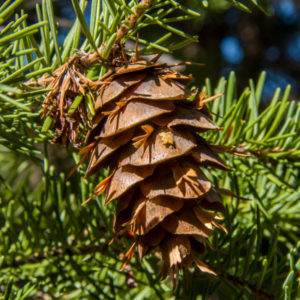 Lush, sprawling forests, trails littered with cones, and the clean, waxy smell of evergreens in the crisp morning air: Colorado. This state is known for its towering lodgepole pines, pale blue spruces, and the Douglas-fir tree – arguably three of the most iconic evergreens in Colorado, if not the entire country. These trees individually play an incredibly important and unique role in the complex ecosystem of the High Rockies. Yet, despite their special statuses as hallmark Colorado trees, we can all admit that, well, these trees all sort of look the same. That’s because they are all conifers! So, what exactly is a conifer?
Lush, sprawling forests, trails littered with cones, and the clean, waxy smell of evergreens in the crisp morning air: Colorado. This state is known for its towering lodgepole pines, pale blue spruces, and the Douglas-fir tree – arguably three of the most iconic evergreens in Colorado, if not the entire country. These trees individually play an incredibly important and unique role in the complex ecosystem of the High Rockies. Yet, despite their special statuses as hallmark Colorado trees, we can all admit that, well, these trees all sort of look the same. That’s because they are all conifers! So, what exactly is a conifer?
As the name would imply, conifers are cone-bearing plants. The unique shape and size of mature (female) cones varies between spruces, pines, and firs, but all have the same basic features. All cones have seed scales that overlap with one another, much like a fish’s scales. When these cones fall to the ground, if the conditions for dispersal are appropriate, the seeds will break away from the cone and (hopefully) find their way into the ground, where they can begin the process of growing into a tree.
Though all of the conifers in Colorado share a variety of characteristics, upon closer inspection, pines, spruces and firs are distinct in a number of ways. Learning how to distinguish between conifers may be a bit tedious, so I like to play a fun alliterative game called, “Let’s meet a tree!”
Step one: Locate a conifer, identifying one by the needles that replace traditional, flat leaves or cone-like structures.
Step two: Shake the branch of the tree, as though you were shaking hands with another person.
Step three: Determine how it feels. Is it spikey? Soft? Roll the needles between your index finger and thumb. Now refer to the key below.
- Are the needles sharp to the immediate touch? Do they roll between your fingers due to their square shape? Then you have just met a spikey, square spruce! The species of spruce that are most commonly seen in the Eagle Valley are the blue spruce (the state tree of Colorado) and Engelmann spruce. Spruce cones tend to be oblong, with flakey seed scales that may be plucked easily and crunch when squeezed.
- Are the needles softer and thin? Are they flat and difficult to roll between your fingers? You have just met a flat, friendly fir! Fir trees are widespread across the western half of the United States, and the ones commonly found here are the subalpine fir and the Douglas-fir. Fir cones are long and thick and have winged-seeds that stick out beyond the scale, which may resemble a snakes tongue or a pitch fork.
- Do the needles come in pairs, or triplets, or quintuplets (that is, groups of five)? Are they long and slender and a little prickly? You have just met a paired pine! Lodgepole pines and ponderosa pines are the major players in our valley, with lodgepole pines having needles in fascicles (or bundles) of two and ponderosa pines having needles in fascicles of two or three. Pine cones (yes, true pine cones) are the archetypal cones, with thick, woody seed scales that are difficult to dislodge. Lodgepole pines have cones that are serotinous, meaning that they are tightly sealed with resin that must be melted away by fire before the seeds can dispersed.
Next time you’re out in nature, take the time to meet and greet the trees in your community. You may be surprised by the diversity of conifer trees and have a greater appreciation for the evergreens that call this valley home, much like you and I.
Marley is a Naturalist and Sustainability intern at Walking Mountains Science Center in Avon, Colorado. Her fascination with evergreen ecology stems from her background as a student in the biological sciences and interest in population ecology. She also credits her love of nature to her parents, who taught her to always appreciate the natural beauty of the world.









